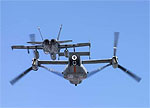Report: V-22 Osprey to take over carrier deliveries
 The days of catapult shots and arrested landings will soon be coming to an end for mail, parts and passengers headed to and from aircraft carriers, as the Navy plans to phase out its aging C-2A Greyhounds in favor of the V-22 Osprey for carrier on board delivery missions.
The days of catapult shots and arrested landings will soon be coming to an end for mail, parts and passengers headed to and from aircraft carriers, as the Navy plans to phase out its aging C-2A Greyhounds in favor of the V-22 Osprey for carrier on board delivery missions.
The Navy has decided to buy four tiltrotors annually from fiscal 2018 to 2020 as the next-generation COD aircraft, a development the service had been eyeing for years. The decision came in a Jan. 5 memo signed by Navy Secretary Ray Mabus, Chief of Naval Operations Adm. Jon Greenert, and Marine Corps Commandant Gen. Joseph Dunford, the existence of which was first reported by the website Breaking Defense.
The Navy has long sought to replace the 35 aging turboprop aircraft that shuttle passengers and cargo to and from the fleet's flattops. The newest C-2As date from 1990. Northrop Grumman, the Greyhound's manufacturer, pitched an upgraded COD as a replacement. Its plan was to retrofit Greyhounds with new wings, a new cockpit, more fuel-efficient engines and most of the tail from the E-2D Advanced Hawkeye.
Officials instead went with Bell-Boeing's MV-22 Osprey. The versatile tiltrotor is able to perform carrier delivery missions and has also been looked at for search and rescue and special forces missions. An added plus is that it can land on a variety of ships. So it is not only able to perform the role of the COD but also bring people and equipment to amphibious assault ships, transport docks and other Navy ships.
Navy officials said they were unable to talk about an internal memo. Cmdr. Thurraya Kent, spokeswoman for the assistant Navy secretary for research, development and acquisition, said she was "unable to release internal correspondence or discuss specifics at this point in time. Our recommended way ahead will be submitted as part of the normal budget process."
Asked about the decision at a Jan. 15 public appearance, Navy Secretary Ray Mabus declined to comment on the memo, saying only that the "possible use" of the V-22 for COD missions was a good example of saving money by using a tested airframe rather than developing a new one.
Bell Helicopter and Northrop Grumman did not respond to requests for comment by press time Jan. 16.
"We are standing by to support the Navy's requirements as outlined in the fiscal year 2016 budget request," Boeing spokeswoman Caroline Hutcheson said in an email.
Ospreys landings have been more frequent in the past three years. The aircraft carrier Harry S. Truman completed a successful Military Utility Assessment last summer in which officials examined whether the Osprey could operate during a flattop's busy take-off and landing cycles.
The tiltrotor aircraft, which has seen extensive combat action in Afghanistan and Iraq, has been dogged by negative publicity dating to its earliest days, when separate crashes claimed the lives of dozens of Marines. More recently, safety concerns arose in Japan, where civilians and some politicians protested the Marine Corps' intent to fly Ospreys over densely populated parts of Okinawa. Japan has since decided to acquire its own fleet of Ospreys.
A classified 2013 report by the Defense Department Inspector General's Office also raised concerns about the way Osprey readiness was recorded. A summary of findings found that commanders in five of six squadrons used erroneous aircraft inventory reports and work orders from fiscal 2009 through fiscal 2011. Squadron commanders also submitted incomplete or inaccurate readiness reports.
"As a result, the [mission capability rates] were unreliable, and senior DoD and Marine Corps officials could have deployed MV-22 squadrons that were not prepared for missions," the summary said.
Still, Navy officials have looked favorably on the Osprey in recent years. Instead of 35 Greyhounds, any Navy Osprey could fly a COD mission — and switch between carrier logistics at sea and moving people and cargo ashore. There also would be a single training and maintenance pipeline.